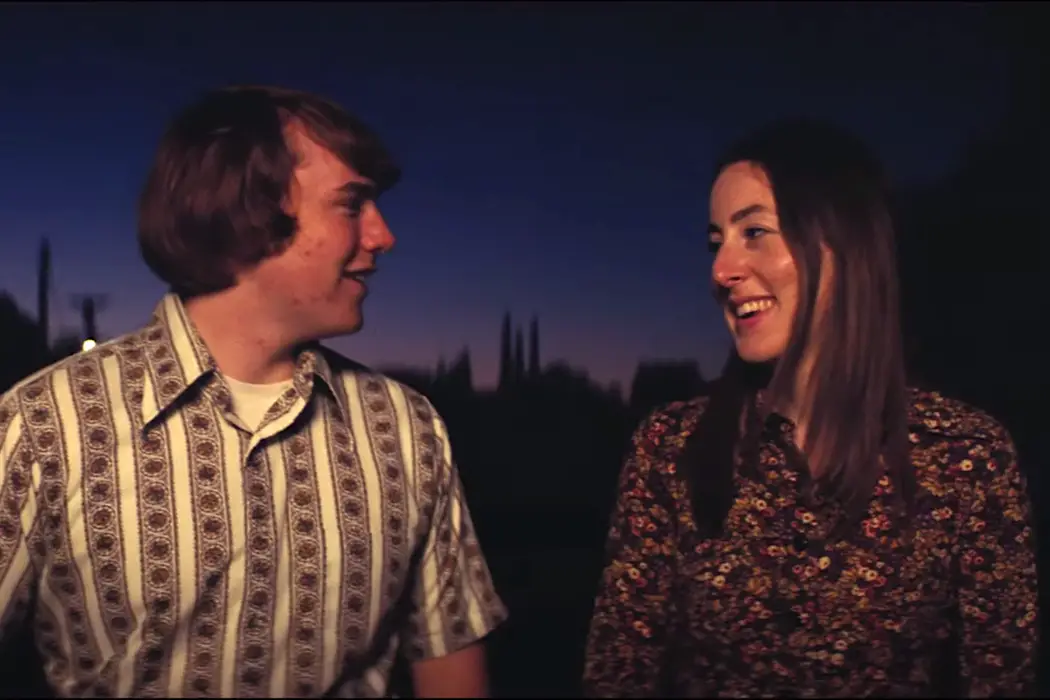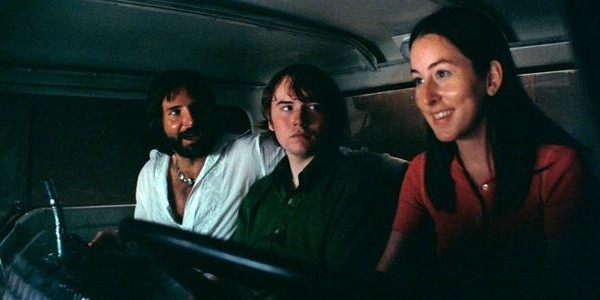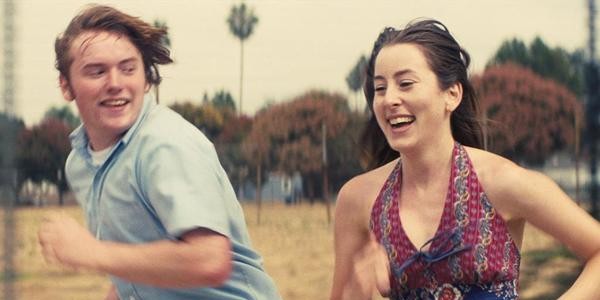Licorice Pizza: Paul Thomas Anderson’s Joyous 70s Teen Romp

Gary’s 15, Alana’s 25. The first time he sees her is at a yearbook photoshoot as she paces up and down the line of students offering a brush and mirror for last-minute touch-ups. And with the overconfidence and thirst of a teenage boy who thinks he’s got casanova, Gary asks her for a date. She teases him, both because the job she’s doing is an absolute bore and because there’s something humorous, maybe even a bit flattering about the way he’s asking. She agrees, maybe to call his bluff or maybe because this so-called “date” can’t be much worse than staying at home.
But by the time Alana arrives later that night, it’s clear even she doesn’t know why she agreed. “Do you think it’s weird I hang out with Gary and his friends all the time?” she asks a sister later in the film. “I think it’s weird I hang around Gary and his 15-year-old friends all the time.” It’s an admission of the absurdity at the heart of Licorice Pizza; the bond and friendship between this young woman, searching for a way into adulthood, and the ambitious teenager who acts as though he’s already arrived.

Gary, a hustling child actor, and businessman is merely the most interesting thing in Alana’s life, and his endless schemes and side-hustles act as the engine for the movie’s comic mania. Licorice Pizza is at once a hilarious romp through LA’s San Fernando Valley (the playground of its director; Paul Thomas Anderson) but also a story of two people who keep finding themselves pulled to one another, even if it’s never in as romantic as scenario as Gary initially fantasizes over, and eventually find at the end they need each other more than initially expected.
Paul Thomas Anderson’s Nostalgic Trip Home
Placing itself in a lineage of episodic shaggy teen comedies like American Graffiti and Dazed & Confused, Licorice Pizza is ripe with youthful energy. Its characters always feel on the move, as if darting from one misadventure to the next, in a hurry to get to the next “thing” before it’s even begun. That gives the picture a lightness of touch, even as its magic hour sunsets and elaborate tracking shots remind you you’re in the hands of one of the great working American filmmakers.
But that hand also feels less forceful, less fussy. Anderson is admittedly -to the surprise of no one who knows me- maybe my favorite filmmaker and his style and ambitions as one have changed constantly over the years. His early work in the 90s was fast, stylish, and kinetic with movies like Magnolia and Boogie Nights; massive ensembles made in the style of such greats like Martin Scorsese or Robert Altman. They fully represent the work of someone eager to make movies like his heroes and with the confidence (much like the protagonist in his new film) to declare himself in that lineage.
And yet, after a brief interlude with the wonderfully eccentric Adam Sandler vehicle Punch Drunk Love, the movies become more operatic in their themes, more patient in their filmmaking. Works like There Will Be Blood and The Master feel like thunderous novels as you’re watching them, reaching for some greater truth about America as an idea and as a country. They lack the coked-up energy of Anderson’s early work but instead feel more precise and more singular.
Which is why it’s fascinating now that Anderson’s films are less burdened by the weight of importance. They’re softer, more deliberate plays in genre but still filled with his eccentricities as a storyteller. The decisions on where to cut and how to move the camera feel predicated on “showing off” — as fun as that can be — but rather how to most effectively and gracefully capture his characters and the world he creates on screen.

Licorice Pizza’s nostalgia-soaked 70s aesthetic feels like coming home for Anderson, after a brief hop over to the UK for his previous film, the darkly funny costume drama Phantom Thread. And Anderson in his way has become one of the foremost chroniclers of southern California in the movies. Even as his style has evolved and his movies change time periods, LA and specifically the Valley, have remained constants.
Yet, the aching sincerity of the images on screen suggests a desire to recapture the image of his hometown from, if not his childhood, at least his childhood imagination. Many will no doubt make the comparisons to Tarantino’s LA memory piece Once Upon a Time…in Hollywood, with its loving fetishization of period-specific locations and lights, lite up just as they were decades before. But, the Valley is not Hollywood and Anderson captures a world in which glitz and glamour seem adjacent but not always at the center.
A Crazed Collection of Characters
Figures who are either real or thinly veiled versions of real people appear and disappear from the narrative like characters in some weird local tall tale, the kind of celebrity sighting that may not be 100% true but at least makes for a good story. It’s these sections that display the movie’s starriest cast members from Sean Penn as a William Holden-type with a love for booze, young women, and motorcycles, to Uncut Gems co-director Bennie Safdie as real-life LA city councilman Joel Wachs. Both are good and there are plenty more fun supporting performances, though none with as much bring-down-the-house energy as Bradly Cooper playing Hollywood hairdresser and mega-producer Jon Peters. His sequence might be the highlight of the movie, with Cooper recapturing the blow-hard attitude of his performance in Wedding Crashers, played against one of the most perfectly orchestrated screwball set pieces in recent memory. Let’s just say it involves a waterbed delivery in an oversized truck and gas shortage creating chaos throughout the nation.

But, while the movie’s edges are filled with a plethora of stars, its newcomers Cooper Hoffman and Alana Haim truly give the film its heart and soul. Both give the kind of comfortable, effortless movie-star performances that can be difficult to achieve with younger actors. But, both have their histories with Anderson. Hoffman’s father, the late great Phillip Seymore Hoffman was a constant throughout much of Anderson’s filmography, bringing either an earnest sweetness or a thunderous air of menace to much of those pictures. But, while Hoffman’s mannerisms and physical cues are often fully present in Cooper’s performance, he manages to be an entirely different kind of actor from his late father.
Cooper by comparison is much more open, without any of the churning psychology that often flowed through his father’s more fascinating characters. By comparison, he’s much more of a showman and captures the confident charisma Gary uses to open doors. Even when the action is boyish, Cooper sells the moment as though he’s the smoothest in the room, such as ordering a round of Cokes at a bar with the bravado of James Bond ordering a martini.
Haim meanwhile gets arguably the movie’s hardest role, playing a young woman caught between angsty girlishness and a worn-out adult. In just one scene she can feel like one of the boys as well as their mother. And while some will no doubt be familiar with her through the band she’s in with her sisters — also called Haim — her presence as an actor feels like untapped gold, something perhaps no one would have discovered had Anderson not directed many of the group’s music videos.
Conclusion
While the movie itself is not without its bumps — a recurring joke about a supporting character’s attitude towards Japanese culture maybe doesn’t land as gracefully as intended — there is always a new adventure, a new gag, a new moment of blissful sweetness just around the corner. Anderson’s movie is a celebration of youth and the thrill of being young; its structure loose and digressive but always with Haim and Cooper as its guiding center. Their connection and chemistry become what lingers long after you leave the film, a moment of connection at a point in life where it feels like something wonderfully unexpected lies behind every turn.
What do you think about Paul Thomas Anderson’s nostalgia-filled coming of age film? Let us know in the comments below!
Licorice Pizza had a limited release on November 26th and will be released nationwide in the US on December 25th.
Watch Licorice Pizza
Does content like this matter to you?
Become a Member and support film journalism. Unlock access to all of Film Inquiry`s great articles. Join a community of like-minded readers who are passionate about cinema - get access to our private members Network, give back to independent filmmakers, and more.













